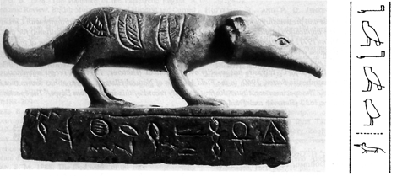Back to The Shrew Main Pages:
Shrew Home - Shrew
Bibliography - Shrew Photo Gallery - Shrewists
on E-mail - Shrew Talk Newsletter - Shrew
Facts & Stories - Shrew Links - Shrew
Inquiries - Shrew Congress Announcements
- Shrew Leisure -
Shrew Chat /
Congress Hall - Shrew
Project Proposals - Shrew
Funding - Shrew
Giftshop - ©
Copyright Disclaimer - Shrew
Guestbook
Go to Sub-Pages: Shrews
in Ancient Egypt - Legends, Folklore &
Myths - Poisonous Shrews - The
Shrew You Find - Fish as Predators on Shrews
- Other Strange Shrew Stories - The
Egg's Philes
Shrew Culture, Myths,
Stories and Poisonous Facts... 

Shrews in Ancient Egypt

Examples of the role of shrews in ancient Egypt: Left, a
small bronze dedicated to the winged god Horus; Right, hieroglyphs from
the Kahun papyrus.
(Figures by Brunner-Traut 1965, reproduced
from Hutterer, R., 1994, with permission)
Mummified shrews that were found in the ceremonial animal tombs of
Akhmim near Thebes, Egypt, date from the 27th dynasty (2400 yr B.P) and
represent six species.
Shrews and other vertebrates had an important place in the religion
of the ancient Egyptians, particularly in the late dynasties (Lurker 1974).
Together with nightjars, mongooses, snakes, toads, and beetles they formed
the terrestrial animals "coming from the dark", whereas falcons
and swifts formed the animals of the light (Kessler 1989). In the view
of Brunner-Traut (1965), shrews and mongooses may have represented two
sides (night and day, dark and light) of the same deity. Along the Nile
the Egyptians built many animal cemeteries, for which they used the term
"restingplaces of the God Osiris-animal" (Kessler 1989).
(Text, shortened, taken from: Hutterer 1994).
The extinct shrew species: Crocidura balsamifera
Further literature:
453 Boessneck, J. (1988). Die Tierwelt des Alten Ägypten.
C.H. Beck, München, 197 pp.
578 Brunner-Traut, E. (1965). Spitzmaus und Ichneumon als Tiere
des Sonnengottes. Nachrichten der Akademie der Wissenschaften in Göttingen,
I, Philologisch-Historische Klasse 1965, 7: 123-163.
2130 Heim de Balsac, H., P. Mein (1971). Les musaraignes momifées
des hypogées des Thebes. Existence d'un metalophe chez les Crocidurinae
(sensu Repenning). Mammalia 35: 220-224.
2373 Hutterer, R. (1994). Shrews of ancient Egypt: Biogeographical
interpretation of a new species. Pp. 407-414. In: J.F. Merritt, G.L. Kirkland
Jr., R.K. Rose (eds.). Advances in the Biology of Shrews. Carnegie Museum
of Natural History Special Publication no. 18, x + 458 pp.
2737 Kessler, D. (1989). Die heiligen Tiere und der König.
Teil I. Beiträge zu Organisation, Kult und Theologie der spätzeitlichen
Tierfriedhöfe. Ägypten und Altes Testament, O. Harrassowitz,
Wiesbaden 16: 1-303, 10 pls.
3227 Lortet, L., C. Gaillard (1903). La faune momifée
de l'ancienne Egypte. I. Archives du Muséum d'Histoire Naturelle
de Lyon 8: 1-205, pl. 1-5.
3246 Lurker, M. (1974). The gods and symbols of ancient Egypt.
Thames and Hudson, London, 142 pp.
(References taken from "The
Shrew Bibliography")
Copyright
© Disclaimer
This web site was created by
Dr. Werner Haberl. Address: Hamburgerstrasse
11, A-1050 Vienna, Austria.
E-mail: shrewbib@sorex.vienna.at
URL: http://members.vienna.at/shrew
![]()
![]()
![]()
